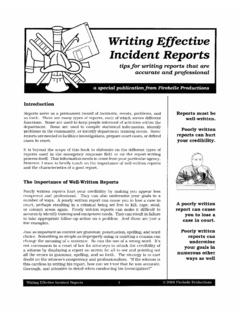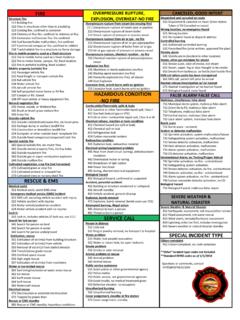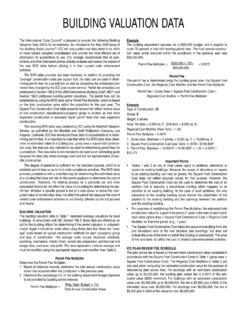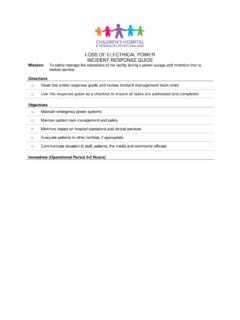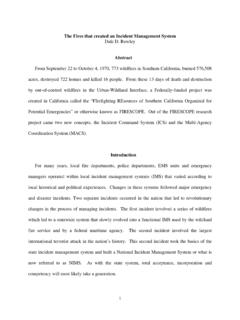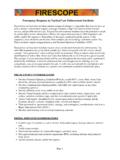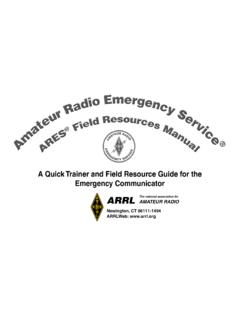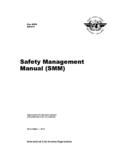Transcription of NFIRS Incident Types - National Fire Information …
1 NFIRS Incident Types Why aren't they telling a clearer story? January 2016. Karyl Kinsey, Austin Fire Department Marty Ahrens, NFPA. January 2016 National Fire Protection Association ABSTRACT. The Fire Administration's (USFA's) National Fire Incident Reporting System ( NFIRS ). collects more than 22 million Incident reports from 23,000 fire departments in the United States on an annual basis. The purpose of this project was to evaluate issues related to data reliability for a key field in NFIRS , the Incident type. Related studies were reviewed and a series of coding exercises testing reliability were conducted by coding narratives from samples of incidents provided by three urban fire departments and comparing the codes with Incident Types selected by reporting officers.
2 Reliability was generally low at the detailed code level, but showed marked improvements when Incident Types were grouped into smaller numbers of categories. Both qualitative and quantitative analyses identified several challenges to data reliability, including the length and complexity of code lists and inconsistencies in documentation and coding guidance. Of particular note was the problem of fitting complex, multifaceted situations into a single code list that incorporates multiple attributes. The analysis also noted the lack of codes capturing community risk reduction efforts occurring in the course of emergency responses.
3 Recommended improvements include developing and disseminating clearer coding guidance for common problems identified and making greater use of social science expertise when designing future versions of NFIRS . Of key importance is the need to understand better how firefighters categorize incidents at the operational level. Acknowledgements We are grateful to the firefighters around the country who prepare NFIRS reports, to the USFA for maintaining the system and trying to address the needs of their diverse constituents, and to state NFIRS program managers who maintain the system at the state level.
4 We thank the Columbus, Memphis and Austin Fire Departments for sharing their NFIRS data; the Austin Fire Department for use of its facilities and a partial match of Kinsey's time; the NFPA for funding the project; and our advisory panel for their input, insight, and support. Advisory Panel Members Buddy Cantrell Memphis Fire Department Mathew Caserta Columbus Fire Department Gregg Cleveland LaCrosse, WI Fire Department Monica Colby Rapid City, SD Fire Department Derryl Dion Massachusetts Department of Fire Services Edee Edwards National Fire Protection Association Christopher Farrell National Fire Protection Association David Icove University of Tennessee at Knoxville Gayle Kelch United States Fire Administration Joseph Maruca West Barnstable Fire Department Lori Moore-Merrell International Association of Firefighters Phil Oakes NASFM Foundation / Narva and Associates Aimee Roundtree Texas State University For more Information about the National
5 Fire Protection Association, visit or call 617-770-3000. To learn more about the One-Stop Data Shop go to or call 617-984-7451. Copies of this analysis are available from: National Fire Protection Association One-Stop Data Shop 1 Batterymarch Park Quincy, MA 02169-7471. E-mail: Phone: 617-984-7451. NFPA No. USS24. Executive Summary NFIRS provides detailed Information to help us understand the fire problem and describe the wide range of other fire department responses. The National Fire Incident Reporting System ( NFIRS ) is the source of much of what we know about the fire experience.
6 Under the umbrella of the Fire Administration's National Fire Data Center, NFIRS allows fire departments around the country to use a standard system to describe their responses. It provides valuable Information about fire department responses of all Types and fire causes and circumstances. Many say the system has grown too complex and unwieldy. Many concerns have been raised about data quality. There is clearly room and need for improvement. Little work has been done assessing NFIRS data reliability, the consistency of coding similar incidents the same way.
7 This study explores reliability issues for one data element in the NFIRS . report, the three-digit Incident type. Many of the general findings are likely applicable to other data elements in NFIRS . The larger goal was to suggest short- and long-term avenues for improvement. Incident type is a key data element in NFIRS . Incident type is defined as the actual situation that emergency personnel found on the scene when they arrived. Not only does it describe the type of situation encountered, it also determines what data modules will be required, and consequently, what additional Information will be collected.
8 The authors coded samples of non-EMS, non-rescue Incident narratives from three urban fire departments, comparing their choices of Incident type with each other and with those chosen by reporting officers. Supporting NFIRS documentation, other studies related to NFIRS , and related social science literatures were also reviewed. The number of Incident type codes more than tripled from Version to the current Version of NFIRS . The number of Incident type codes increased 240%, from 52 in Version of NFIRS to 177 in NFIRS This was due to both a decision to make NFIRS an all Incident .
9 Reporting system and the desire for more detailed breakdowns of prior code Types . For example, the number of codes for hostile fires increased from nine generic categories to 41 across versions, an increase of 356%. The increase in Incident Types created new challenges to obtaining consistent classifications of incidents. In practice, the size of the working coding scheme for non-EMS/rescue incidents appears much smaller than the full coding scheme. Excluding emergency medical services (EMS) and rescue calls, in all three cities about three-fourths of incidents were coded using just 15 (10%) of the 149 Incident Types codes studied.
10 Nationally, 15 Incident Types accounted for 59% of these 149. The bottom 60% of codes (88-89 codes, depending on ties) accounted for only 2% of non-EMS, non-rescue incidents reported in the three study cities, and 6% nationally. What is a fire? Incident type instructions do not include a clear definition of fire. The NFIRS . Coding Questions Manual specifies actual flame damage as the key criterion for defining exposure fires, which are situations where fires cause other fires in nearby properties. The NFIRS Complete Reference Guide (CRG), in contrast, makes no mention of flames as a criterion for classifying fire Incident Types in the 100 series.
